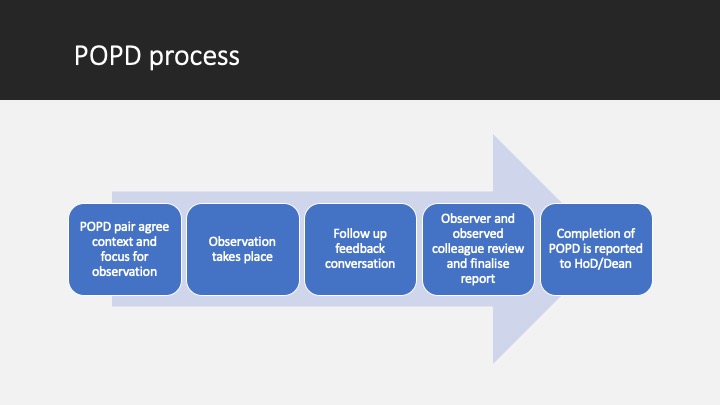Peer observation for professional development policy
Peer observation of teaching is recognised across the UK HE sector as a means of enhancing practice through garnering feedback from colleagues, learning from observing others’ work and engaging in open and collegial conversation.
POPD aims to build self-awareness and encourage peer learning, support colleagues’ professional development and enhance teaching and student experience. The value of POPD resides in the space it creates for dialogue around pedagogic practice, and the ideas, insights and developments that can emerge through these conversations. The St Mary’s POPD policy is predicated on the sharing and development of practice and the understanding that peer observers are learning from the opportunity of reviewing a colleague’s work as well as offering constructive feedback. The POPD scheme is not to be used as a performance management tool.
- Colleagues determine at local level how they would like to undertake peer observation and with whom. For example, there may be selection around the following:
- what types of activities (classroom teaching, online delivery, assessment and feedback practices) might be peer reviewed
- how peer observers will be chosen, and
- whether reviewers work in pairs, trios or small groups. It is important that all parties are comfortable with the observation arrangements in order for the activity to be of maximum benefit.
- Typically, a peer observation will operate on a reciprocal basis with each member of the pair (or small group) acting as the observer and the observed colleague. Ideally, colleagues should both be observed and act as an observer for a peer. However, the minimum expectation is that everyone should be observed.
- Once a pairing has been agreed, colleagues will do the following:
- discuss the timing, context and content of the observation
- identify aspects of the teaching that the observed colleague would like to have considered, and
- undertake the observation.
- The observation will be followed by a feedback conversation in which both colleagues can share impressions of the session/activity being reviewed. The observer will then complete a draft observation report which will be shared with the colleague who has been observed. A final report, including reflections from the observed colleague, is then produced. This report is confidential (see principle 7).
- The observed colleague should report to HoD/Head of School/Dean that the observation process has been completed.

There are many potential areas for review. The most common approach is to review a live teaching session. However, other options would be to review the following:
- assessment and feedback practices
- online design and delivery
- a course Moodle site
- proposed new programme/course design
- a theme such as employability or inclusivity across a programme.
Decisions around the focus for the peer review can be taken at local level.
- The primary purposes of the policy are to a) promote sharing of practice and b) support colleagues’ professional development by offering insight into their teaching and pedagogy.
- Teaching observation reports will not be used for performance management purposes.
- All colleagues who teach or directly support student learning (such as colleagues offering academic study support) will be expected to participate in peer observation. This will ensure parity of opportunity and potentially enable closer working between staff in different student-facing roles.
- Peer observers can be selected from either within or outside of a colleague’s own subject specialism or department. Potential advantages of the latter arrangement are that a) the primary focus is on pedagogy (rather than subject content) and b) practices from different disciplines are shared more broadly across the University.
- Members of POPD pairings can be at different stages of their careers and/or at varying levels of seniority. A pairing[1] organised in this manner has the potential to increase the innovative practices and range of experiences to which colleagues are exposed.
- Observation opportunities can be drawn from a wide range of teaching activities including classroom teaching (lectures, seminars), fieldwork, lab sessions, practice-based learning, coaching, personal tutoring meetings (where appropriate and with permission from students), research supervision (with permission from students), online teaching, learning development sessions and similar.
- Reporting and confidentiality: Staff are expected to report their completion of peer observation to their HoD/Dean, but feedback and discussions between participants remain confidential.[2] Only the fact that the observation has taken place is reported.
Teaching observation reports are confidential to the observer and the observed colleague (see principle 7). However, the observed teacher may wish to draw upon a report for evidence to inform HEA fellowship applications and promotion cases.
Reports can help individuals reflect on achievements and identify and prioritise areas for future CPD.
- The observation is a confidential conversation between the reviewer and the colleague(s) being observed.
- The observed colleague should report to the HoD (or equivalent) that the review process has been completed. Copies of observation reports should not be requested.
- HoD/Subject lead should report numbers/rates of completion (not names) to their Dean/Director.
- Deans/Directors should report rates of peer observation to the relevant comittee (for ex. IADC/FADC).
- ADC will receive reports on peer observation completion rates.
Below are resources on techniques for peer review and templates for conducting observations.
Peer observation for profession development (POPD) policy, approved by ADC, March 2022.
Template for a structured peer observation.
For further information, please contact Dr Colleen McKenna in CTESS.
[1] The term ‘pairing’ is used throughout the document because this is likely to be the default arrangement. However, colleagues may choose to work in trios or small groups to undertake observations.
[2] Exemption from confidentiality will apply only where there is an overriding reason enshrined in law or University policy, e.g. if the observed practice raises concerns about staff misconduct or safeguarding.